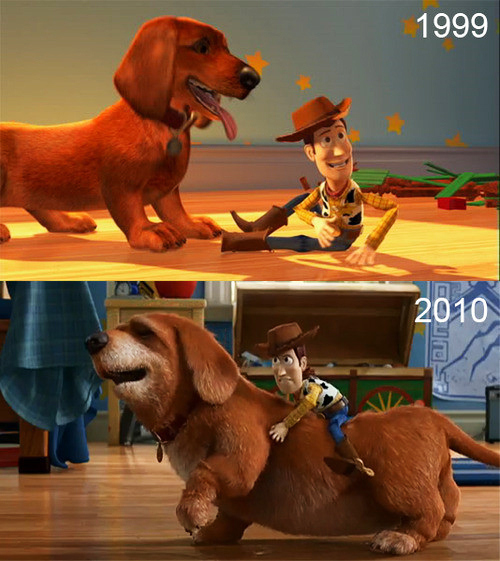Animation
Stop-motion animation (pages 136 and G-7): A variation on drawn animation techniques that uses puppets or other three-dimensional objects. To give the appearance of life on film when projected at the normal 24-frames-per-second speed, subjects are moved minimally between shots as they are being photographed.
Hand-drawn animation (not in textbook): Animation in which each frame is drawn by hand and then photographed. To give the appearance of life on film when projected at the normal 24-frames-per-second speed, each subsequent drawing depicts a small change in position.
Cel animation (not in textbook): a technique used for hand-drawn animation in which characters are drawn and painted on sheets of clear celluloid (or “cels”). The cels are placed over a separate background image and photographed one by one. The advantage of this technique is that it cuts down on the amount of drawing involved, since you don’t need to redraw the background in each frame.
Computer-generated images, or CGI (pages 134 and G-2): Visual images that are created exclusively by computer commands rather than by standard live photography or stop-motion animation. This method has been widely used in many types of films, but only during the 1990s did entirely CGI features such as Toy Story and A Bug’s Life appear.
Top: Toy Story 2 (1999) Bottom: Toy Story 3 (2010)

Andre Bazin, “The Ontology of the Photographic Image,” pp. 7-8:
Photography’s originality compared to painting thus lies in its objective nature; in French the lenses of the photographic eye are called, precisely,obectifs. For the first time, the only thing to come between an object and its representation is another object. For the first time, an image of the outside world takes shape automatically, without creative human intervention, following a strict determinism. The photographer’s personality is at work only in the selection, orientation and pedagogical approach to the phenomenon: as evident as this personality may be in the final product, it is not present in the same way as a painter’s. All art is founded upon human agency, but in photography alone can we celebrate its absence. Photography has an effect upon us of a natural phenomenon, like a flower or snowflake whose beauty is inseparable from its earthly origin.
The automatic way in which photographs are produced has radically transformed the psychology of the image. Photography’s objectivity confers upon it a degree of credibility absent from any painting. Whatever the objections of our critical faculties, we are obliged to believe in the existence of the object represented: it truly is re-presented, made present in time and space. Photography transfers reality from the object depicted to its reproduction. The most faithful drawing can give us more information about the model, but it will never, no matter what our critical faculties tell us, possess the irrational power of photography, in which we believe without reservation.


So why does all this matter?


http://www.cbc.ca/news/trending/paris-attacks-canadian-sikh-selfie-photoshop-1.3320327
Another case study: the ubiquitous lens flare
Lev Manovich, The Language of New Media
What happens to cinema’s indexical identity if it is now possible to generate photorealistic scenes entirely in a computer using 3-D computer animation; to modify individual frames or whole scenes with the help a digital paint program; to cut, bend, stretch and stitch digitized film images into something which has perfect photographic credibility, although it was never actually filmed?
Manovich’s answer:
Consequently, cinema can no longer be clearly distinguished from animation. It is no longer an indexical media technology but, rather, a subgenre of painting.
